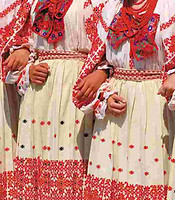.jpeg)
Zrinski Frankopan
Croatian Folkore Ensemble

Folk Costumes
Showcasing the Diversity and Individuality of Different Regions
Zrinski Frankopan performs folk dances from various regions across Croatia, showcasing the unique nature of each area with respect to their dance, costumes, personality and social customs. We are also proud to represent Croatians outside of the borders of the Republic of Croatia, helping them maintain their ethnicity and cultural traditions where they are a minority.
The group houses an inventory of original folk costumes from many regions of Croatia. These costumes, however, represent only a small subset from each of the regions. Folk costumes are a fundamental part of Croatia's cultural heritage and reflect the social, cultural and historical influences of particular geographical areas and climates. Folk costumes differ not only across regions, but also within. Each region has its own specific variety of costumes that vary in style, material, colour, shape, and form, though often share traits of elegance and intricacy of design.
Our most popular dances and choreographies stem from Panonnian Croatia, the eastern lowlands north of the Sava and Danube rivers, namely Posavina, Prigorje and Slavonija. Dances from this region are easily recognized by the inclusion of rhythmic bouncing and shaking steps, called "drmeš", and their beautiful, colourful costumes.


Posavina
Posavina is a region in the central part of northern Croatia. Costumes from the Posavina region are undeniably some of the most beautiful and elaborate in the country. You will easily recognize these costumes by their vibrant colours and breathtaking floral design carefully embroidered by hand, or contrast of red and white woven patterns ("Mašinski Vez"). These are the group's most featured dance costumes as they are used for a variety of dances, such as its signature dance "Lijepa Moja" (My Beautiful).





Slavonija
Slavonija, the most eastern of the Croatian lowlands, is one of the most folklore-rich regions with many diverse costumes, such as the "Vezanica" (featured right), "Bapska" and "Šokačka". These costumes typically feature elaborate hand-crafted designs, beautiful colours and a variety of styles reflective of the person's age, social class, marital status, etc.


Bunjevac
As reflected by the elegance and opulence of their costumes, Bunjevci were historically Croatian nobility. Following the Christian-Turkish wars, they migrated from continental Dalmatia and western Herzegovina to the Velebit area, Lika, and Gorski Kotar, as well as Bačka, Vojvodina. These costumes are a symbol of the wealth and affluence of the families, who in the late 19th and early 20th centuries imported silks from Lyon, France and decorated them with gold embroidery.

Linđo
Lika
Šestine

Linđo is a very popular and elegant folk dance that originates from Dubrovnik and surrounding area. While the dance is a more difficult one to master, the costumes are a relatively simple but elegant design.
Lika's mountainous terrain and cooler climate in central Croatia, are reflective of the heavier, wool costumes, often complemented by jackets and vests. Most distinctive is the men's bright red embroidered hat ("Lička kapa"), with its long black back tassel.

Šestine is the northern part of Zagreb, Croatia's capital. A vibrant red colour and other details characterize these costumes, such as hand embroidered vests, kerchiefs and umbrellas. This costume has come to symbolize Croatian folklore, with the iconic 'Šestinske dolls' hanging from many Croatian rear-view mirrors.
